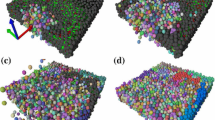Abstract
Using a simple and generic molecular dynamics model, we study damage in a disc of interacting particles as the disc fragments upon impact with a wall. The damage, defined as the ratio of the number of bonds broken by the impact to the initial number of bonds, is found to increase logarithmically with the energy deposited in the system. This result implies a linear growth with damage for the total number of fragments and for the power law exponent of the fragment size distribution.
Similar content being viewed by others
References
Åström JA, Holian BL, Timonen J (2000) Universality in fragmentation. Phys Rev Lett 84: 3061
Åström JA, Linna RP, Timonen J, Møller PF, Oddershede L (2004) Exponential and power-law mass distributions in brittle fragmentation. Phys Rev E 70: 026104
Behera B, Kun F, McNamara S, Herrmann HJ (2005) Fragmentation of a circular disc by impact on a frictionless plate. J Phys Condens Matter 17: S2439
Campi X, Krivine H, Sator N, Plagnol E (2000) Analyzing fragmentation of simple fluids with percolation theory. Eur Phys J D 11: 233–238
Ching ESC, Yiu YY, Lo KF (1999) Energy dependence of mass distributions in fragmentation. Physica A 265: 119–128
Clauset A, Shalizi CR, Newman MEJ (2009) Power-law distributions in empirical data, SIAM Review, to appear (preprint at arxiv:0706.1062)
Diehl A, Carmona HA, Araripe LE, Andrade JS Jr., Farias GA (2000) Phys Rev E 62: 4742–4746
Frenkel D, Smit B (2001) Understanding molecular simulation: from algorithms to applications. Academic Press, Oxford
Grady DE (2008) Fragment size distributions from the dynamic fragmentation of brittle solids. Int J Impact Eng 35: 1557
Holina BL, Grady DE (1988) Fragmentation by molecular dynamics: the microscopic “Big Bang”. Phys Rev Lett 60: 1355
Kadono T (1997) Fragment mass distribution of platelike objects. Phys Rev Lett 78: 1444
Kadono T, Arakawa M (2002) Crack propagation in thin glass plates caused by high velocity impact. Phys Rev E 65: 035107(R)
Kaminski E, Jaupart C (1998) The size distribution of pyroclasts and the fragmentation sequence in explosive volcanic eruptions. J Geophys Res 103: 29759–29779
Kun F, Herrmann HJ (1999) Transition from damage to fragmentation in collision of solids. Phys Rev E 59: 2623–2632
Matsui T, Waza T, Kani K, Suzuki S (1982) Laboratory simulation of planetesimal collision. J Geophys Res 87: 10968
Meibom A, Balslev I (1996) Composite power laws in shock fragmentation. Phys Rev Lett 76: 2492
Mishra BK, Thornton C (2001) Impact breakage of particle agglomerates. Int J Min Process 61: 225–239
Moukarzel CF, Fernández-Sabido SF, Ruiz-Suárez JC (2007) Phase transition in liquid drop fragmentation. Phys Rev E 75: 061127
Myagkov NN, Shumikhin TA (2005) Critical behavior and energy dependence of mass distributions in impact fragmentation. Physica A 358: 423–436
Oddershede L, Dimon P, Bohr J (1993) Self-organized criticality in fragmenting. Phys Rev Lett 71: 3107
Oddershede L, Meibom A, Bohr J (1998) Scaling analysis of meteorite shower mass distributions. Europhys Lett 43: 598
Sator N (2003) Clusters in simple fluids. Phys Rep 376: 1
Sator N, Mechkov S, Sausset F (2008) Generic behaviours in impact fragmentation. Europhys Lett 81: 44002
Thornton C, Yin KK, Adams MJ (1996) Numerical simulation of the impact fracture and fragmentation of agglomerates. J Phys D Appl Phys 29: 424–435
Turcotte DL (1986) Fractals and fragmentation. J Geophys Res 91: 1921–1926
Verlet L (1967) Computer experiments on classical fluids. I thermodynamical properties of Lennard-Jones molecules. Phys Rev 159: 98
Wittel F, Kun K, Herrmann HJ, Kröplin BH (2004) Fragmentation of shells. Phys Rev Lett 93: 035504
Wittel FK, Carmona HA, Kun F, Herrmann HJ (2008) Mechanisms in impact fragmentation. Int J Fract 154: 105
Author information
Authors and Affiliations
Corresponding author
Rights and permissions
About this article
Cite this article
Sator, N., Hietala, H. Damage in impact fragmentation. Int J Fract 163, 101–108 (2010). https://doi.org/10.1007/s10704-009-9406-8
Received:
Accepted:
Published:
Issue Date:
DOI: https://doi.org/10.1007/s10704-009-9406-8




